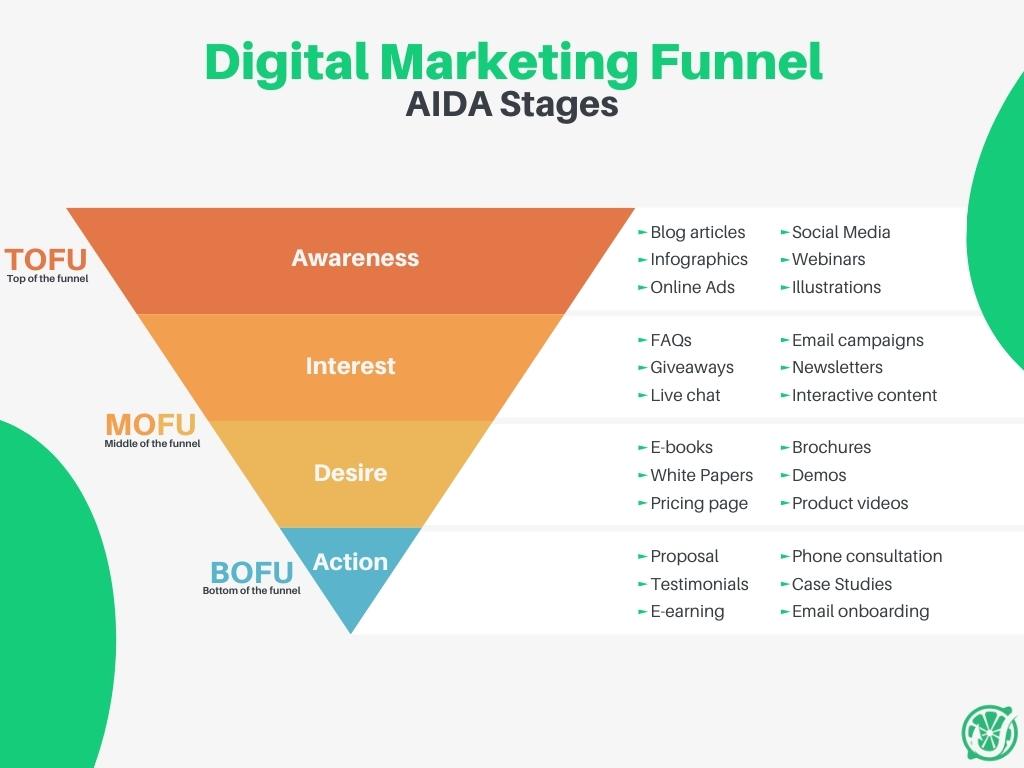
It’s important that every organization would monitor the effectiveness of sales and marketing strategies, know-how the qualified leads find their business and when do they turn to paying customers.
That’s exactly what digital marketing funnels are for and they help to provide business valuable information about your customer’s habits and map out their journey from the first time hearing about your products to becoming a customer.
What’s so special about funnels, is that once you find the working one, ultimately you can multiple it and expect to steadily increase results by X amount of times.
In today’s article, we’ll cover all you need to know about digital marketing funnels, their benefits, and the different type of funnels that exist.
Next, we’ll discuss different marketing stages and share a simple 5 steps process of how you can create one yourself.
Lastly, marketing funnels can become “leaky”, hence in our Bonus part, we’ll share several techniques you can use to quickly fix them.
Marketing Funnels
What’s a marketing funnel?
A marketing funnel or better known as a sales funnel is a visually designed system to attract new customers to your business and transform them into buying customers.
In short digital marketing funnels are made out of 4 different stages: Awareness, Interest, Desire, and Action. Each stage is responsible for different functions and is meant to generate different results. From the first stage when the customer for the first time hears about your business, to the last one when your contacts become your paying customers.
To better understand how the marketing funnel work, think of a boutique store that sells flowers online.
The marketing funnel is made from different stages where the visitor goes through each of them until he becomes a customer. It can look something like this:
- The customer visits the store online
- They view the flowers
- They add them to the shopping cart
- Finally, they proceed to the checkout and choose the pick-up point
Why this all process is called a marketing funnel and looks like an upside-down pyramid?
At the first awareness step, there are always the most people interested in your product. And as the further, you go down the funnel reaching different stages, more and more of them drop out. Resulting within each stage fewer and fewer people remaining within the segment.
Since at each step there are fewer people this all system looks like a funnel with the end part looking squeezed.
What’re the benefits of a digital marketing funnel?
Digital marketing funnels are critical to the way businesses operate and to some degree can assure or at least map out which steps you need to take to generate new leads.
Without delivering consistent results marketing funnels are beneficial for many other reasons:
- It can help your business find the holes within your funnel, and see where you’re losing potential customers
- Well-working funnels can be scalable. Once you get consistent results, multiplying your marketing funnel by X amount would theoretically increase the results
- Marketing funnels can be automated, resulting in saved time and effort
- Working marketing funnels can be easily shared across different teams. This way helps to deliver consistent results and your customers get the same experience within the customer’s journey.
Different types of funnels
The marketing funnel is just one of many other funnels that exist, where each of them could be used for different business goals.
Without digital marketing funnels you’ve might have heard over:
- Webinar funnels
- Sales funnels
- Lead magnet funnels
- Home page funnels
- Email funnels
However, despite their different naming, they all are made for the same reasons, to take your customers from the first time hearing about your brand, to becoming loyal paying customers.
4 Steps of Digital Marketing Funnels
Marketing funnels consists of 4 stages and could be easier remembered by the acronym AIDA:
- Awareness
- Interest
- Desire
- Action
These different stages represent customers being at particular stages within their customer’s journey, and each of them requires a different approach to interact with them. The worst thing you could do is to send a wrong message at the wrong time when people aren’t ready to buy yet. Let’s admit that it would be strange if the restaurant’s waiter would ask you what would you like for a dessert before even ordering drinks or appetizers. To craft, a compelling brand message check our article on copywriting techniques.
Let’s look at each funnel step individually.

1. Awareness
First of all, during the awareness step in the marketing funnel people hear about your brand for the first time and know that you exist. It could be something as:
- Received friend’s referral about your services
- Heard about your brand from a daily podcast
- After Google search for the particular problem
- Saw an ad on social media
- Watched your video on YouTube
And it doesn’t matter much how they find out about your business because they’re concerned about their problem and hope you can solve it. Make sure that your message is clear at this step. Raise awarness of their problem and ensure them that you’re the right fit to fix their problems.
If everything is done well, and their problem is really annoying, there’s a small chance they might convert without proceeding further down the funnel.
2. Interest
Next stage is when your customers have been “hooked” by your brand and now they’re aware that you can help to solve their problem. Now, it’s time to show how your product or service will solve the problem. Demonstrate and prove them why your company is the best fit for the job.
Boost their interest in your brand and show how your product solves the issue by:
- Writing a blog
- Sharing tips on social media
- Launching email campaigns
But be careful, don’t sound too pushy, and avoid hard selling at any cost. It’s too early yet and your customers might fall back if they feel it.
3. Desire
Third stage is the consideration phase. And your customers have already heard about you, and know that you can help them to solve their problems.
In other words, they’re almost ready to buy, but there’s one but.
Your brand is not the only option for consideration, and there are two or three other choices.
Hence, it’s time to make your best offer and show them why you’re the best option among the rest. Do you deliver free shipping or give a special discount? Do you give 2 years warranty? Highlight all these extra features that will help you to stand out among your competition and make your offer irresistible.
To further build trust show them that you’re the right choice by creating the following content:
- Whitepapers that provides value, answer questions, and solves their issues
- Case studies and product comparisons
- Create surveys where people can share their experience within their customer journey
4. Action
At the final step, your customers are almost convinced about your product and how it will help them to solve their problems.
The only thing that is left to do is to slightly “nudge” them towards the final purchase. However, don’t put too much pressure and don’t hard-sell, because in some rare cases people might reconsider your offer and don’t proceed to the checkout.
Assure that by giving them specific reasons why they should choose your brand over the competition:
- Offer a product trial or a demo
- Share social proof of happy customers and how your product helped them
- Create features and price comparisons against your competition
- Write how-to guides answering questions and eliminating the final doubts your customers might have
Lastly, next step is to think about customer retention. Your goal is to keep customers loyal to your product and increase the number of times they buy from you. Do this by expressing gratitude for the purchase, inviting them to give feedback, and making yourself available for tech support.
5 Easy Steps to Create Funnels
Marketing funnels development process can look intimidating at first, so keep it small at first and don’t make things too complicated. But keep in mind the possibility that your funnels would be scalable in the future. Here are 5 simple steps to create an effective digital marketing funnel.
1. Raise Awareness
The first step is to raise awareness of your brand and tell people about your brand and what you do.
Depending on your business goals and industry you operate in you can share your brand story in many different ways, from more traditional ones to more recent digital advertising.
If you run a furniture factory, that makes exclusive designs, you might consider more traditional methods to advertise your brand. Book a spot at a national furniture conference to share your latest designs or buy several spots on street billboards where you can launch advertising campaigns.
On the other hand, if you’re running a SAAS business, focus on more modern ways to promote your product. Launch ad campaigns on Google, YouTube or consider scaling for a broader audience and run ads on social media.
2. Boost the Interest
When people heard about your brand, now it’s time to build a stronger connection with them. Show how your product will solve their problem and provide more information about its main features.
If customers follow you on social media, share some quick facts about your company, pique their interest that your furniture is made from high-quality recycled wood, or that each piece is hand-made and signed by the carpenter that made it.
With each new content piece, include CTA’s and further steps people need to take to proceed down the funnel.
3. Give them reasons to desire your product
Next step is to make your product more desirable than competition. Optimize your content for “top” and “the best” keywords. Create product comparisons and shows how your product is more advanced than the competitors.
For our fictional furniture company, you could create a blog, and write articles over new models highlighting what is so special about them. Or create video content on YouTube where you will compare your designs against the competition.
4. Close the sale
It’s a time to finally convert your visitors into possible customers and you can do this in several different ways. Show them your product quality standards by sharing positive reviews on the checkout page.
Offer a special discount code or if you’re a SAAS company, give them a trial period to test your product free of charge.
For example, our furniture company could offer a special discount for the people buying full kitchen sets.
5. Building loyal customers
The last step is a very important one. And assuming that your customers will return for more purchases without putting in any work would be simply foolish.
Therefore, create a plan to build loyal customers, ask clients to fill in feedback forms, share what they liked about your brand and what could be improved. Set up a technical team that could follow up with the customers in real-time helping to solve their problems.
This way you’ve got a chance that customers will come back in the future to buy again.
Bonus Point
How to fix a leaking funnel?
Creating digital marketing funnels is a never-ending process and you must continue to innovate them to maximize the output. Over some time marketing funnels start leaking, where some people just aren’t interested in your product and won’t buy from you.
Hence, it’s normal that funnels start leaking, but it’s ain’t good when it becomes uncontrollable.
What do you do then, and how do you fix them?
Well, first of all, start measuring the key metrics within your funnel. Track how many people come to your site, measure the Click-through-rate (CTR) of the email sequence, or how many purchases you’ve made during the last period.
If these metrics have changed significantly, let’s say that your purchases have dropped in half during the last period, then there’s a problem with your funnel and it must be fixed.
Depending on your business case you might need different solutions, or you can try these several methods mentioned below.
1. Retargeting
Let’s imagine that you’ve launched a new PPC campaign for your flowers boutique store. You’ve invested €1.000 to get 40 new leads to your newsletter.
The campaign went well, at least that’s how you thought, 4.000 people have visited your site during the last month. A big number, but the problem is that you’ve received only 10 new signups and only 8 of them claimed your ebook on “How to prolong cut flowers to stay longer?”
Therefore, your campaign is just another flop, you’ve failed it and don’t know what to do next.
That’s exactly where retargeting comes to, and it’s a form of advertising that allows targeting people who’ve visited your site earlier with a different offer and encourages them to signup for your newsletter. The truth is that it’s more likely people will convert when they’ve already heard about your brand rather than it’s their first time. Thus, second-time people visiting your site will have a higher chance to convert and signup for the newsletter. Learn how to grow your list in our article on email marketing.
The biggest advertising platforms, including Google, Bing, and Facebook offers retargeting options. In short, you install a piece of code on your website (better known as a pixel) that tracks your website visitors with an anonymous cookie that allows the platforms to show ads to them later in the future.
2. Live chat
It’s a fact that people get frustrated once they are stuck on your site and don’t know how to solve a problem.
Let’s assume that they’ve visited your flowers store and experienced issues with the checkout process that didn’t work. They’ve tried to look up more information on the site, but no luck.
And just about to leave, they’ve discovered a live chat feature. Where one of your employees helps them to solve their checkout issue and proceed with the checkout. Without that they most likely have left your site for a competition where the same process would be easier.
Of course, you’ll need extra resources to set up a live chat support team, though it can be truly valuable and help you to maximize your conversions in your broken funnels.
Conclusion
In conclusion, digital marketing funnels play an important within every business process and without them, it would be just another guesswork of what works and doesn’t to attract new leads.
Marketing funnels are designed to transform contacts visiting your site to paying customers and can help to find holes within your processes and how to the leaking holes. They can be automated and shared across the board expecting to get similar results in the future.
Without marketing funnels, you might have heard about sales, webinars, lead magnets, homepage, and email funnels. Despite each of them being different each of them is meant for the same purpose. Transform your visitors into future clients.
There’re 4 main stages within each digital marketing funnel that starts by people hearing about your brand for the first time and end once they convert to the clients:
- Awareness – a stage where people hear about your brand for the first time
- Interest – show them how your product will solve their problem
- Desire – make your product more desirable than the competition
- Action – “nudge” them towards the final purchase by offering a product demo or a special discount
Over time marketing funnels start leaking where one stage becomes unproportionally incorrect and it should be fixed. Fix them through retargeting or set up a live chat.
To close up, marketing funnels might look intimidating at first, thus keep them simple and develop simple funnel steps that work. Once it’ll work like a swiss watch you can always scale it up for better results.




